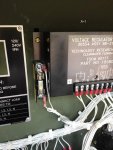- 16,701
- 23,937
- 113
- Location
- Burgkunstadt, Germany
I stand corrected. Just spoke with a friend, and he told me that the 400 hertz exciter stator is NOT compatible to the 60 hertz model. Look at figure 24, item 23. That is the part I mean.
Is this the test procedure you used?
5.2 Troubleshooting Guidelines
If the fuse blows perform the following tests:
a) Disconnect wire # 106B from A1, terminal 8; disconnect wire # 107B from A1, terminal 7.
b) Connect a digital multimeter, set to "ohms," between A1 terminal 7 and A1 terminal 8. Resistance value
should be high. Low resistance indicates a defective bridge rectifier circuit. Perform same test across A1
terminal 7 and A1 terminal 8 in "diode check" mode. Voltage drop should be approximately 1-1.2 VDC. A
zero (0) VDC reading indicates a defective bridge rectifier circuit. If the resistance reading is low or the
voltage reading is zero (0) the A1 must be replaced.
c) With wire #’s 106B and 107B still disconnected, connect digital multimeter, set to "ohms," between wire #
106B and wire # 107B.
d) Check the "Quad" winding for proper resistance (Re: TM 9-6115-641-24, Figure 4-10.7, steps h & i and
TM 9-6115-642-24, Figure 4-10.7, steps h & i) Reading should be 0.9 - 1.2 ohms for the MEP-802/803 and
1.2-1.6 ohms for the MEP 812/813. Verify resistance value does not drop during test. If reading is out of
tolerance the stator must be replaced
e) With "Quad" circuit still disconnected, test engine. If engine takes an excessive amount of time to start
or and/or an excessive amount of time to develop rated speed, troubleshoot the engine fuel system. Verify
that fuel system is free of contaminants. Verify condition of fuel filters. Verify correct operation of electric
fuel pumps. Verify combustion on all cylinders. Verify correct installation and adjustment of injection
pumps. Verify correct operation of injector nozzles. Repair or replace components as necessary.
f) Retest engine and verify correct operation
g) Verify correct readings on A1 and "Quad" winding.
h) Reconnect wire # 106B to A1 terminal 8; reconnect wire # 107B to A1 terminal 7.
i) Install new fuse
j) Test generator set
Is this the test procedure you used?
5.2 Troubleshooting Guidelines
If the fuse blows perform the following tests:
a) Disconnect wire # 106B from A1, terminal 8; disconnect wire # 107B from A1, terminal 7.
b) Connect a digital multimeter, set to "ohms," between A1 terminal 7 and A1 terminal 8. Resistance value
should be high. Low resistance indicates a defective bridge rectifier circuit. Perform same test across A1
terminal 7 and A1 terminal 8 in "diode check" mode. Voltage drop should be approximately 1-1.2 VDC. A
zero (0) VDC reading indicates a defective bridge rectifier circuit. If the resistance reading is low or the
voltage reading is zero (0) the A1 must be replaced.
c) With wire #’s 106B and 107B still disconnected, connect digital multimeter, set to "ohms," between wire #
106B and wire # 107B.
d) Check the "Quad" winding for proper resistance (Re: TM 9-6115-641-24, Figure 4-10.7, steps h & i and
TM 9-6115-642-24, Figure 4-10.7, steps h & i) Reading should be 0.9 - 1.2 ohms for the MEP-802/803 and
1.2-1.6 ohms for the MEP 812/813. Verify resistance value does not drop during test. If reading is out of
tolerance the stator must be replaced
e) With "Quad" circuit still disconnected, test engine. If engine takes an excessive amount of time to start
or and/or an excessive amount of time to develop rated speed, troubleshoot the engine fuel system. Verify
that fuel system is free of contaminants. Verify condition of fuel filters. Verify correct operation of electric
fuel pumps. Verify combustion on all cylinders. Verify correct installation and adjustment of injection
pumps. Verify correct operation of injector nozzles. Repair or replace components as necessary.
f) Retest engine and verify correct operation
g) Verify correct readings on A1 and "Quad" winding.
h) Reconnect wire # 106B to A1 terminal 8; reconnect wire # 107B to A1 terminal 7.
i) Install new fuse
j) Test generator set



